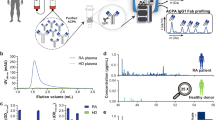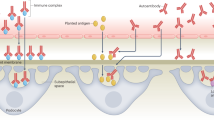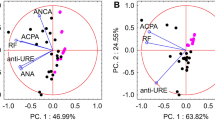Abstract
Autoantibodies that react with cellular components occur in high frequency in patients with systemic rheumatic diseases. A novel class of “autoantibodies” that react with cellular components has been identified in normal humans and other species. Unlike the disease-associated autoantibodies that are restricted in number, these human autoantibodies increase in number from birth until approximately two years after birth, and then remain constant for decades, if not lifelong. The complement of such autoantibodies present in an individual is unique, and for this reason they have been named individual-specific or IS autoantibodies. The IS autoantibodies, when physically separated, comprise an “antibody fingerprint” that can serve to identify people or animals, or their body fluids. These antibodies may also be associated with “security documents” and used for purposes of authentication.
This is a preview of subscription content, access via your institution
Access options
Subscribe to this journal
Receive 12 print issues and online access
$209.00 per year
only $17.42 per issue
Buy this article
- Purchase on Springer Link
- Instant access to full article PDF
Prices may be subject to local taxes which are calculated during checkout
Similar content being viewed by others
References
Jeffreys, A.J., Wilson, V., and Thein, S.L. . 1985. Hypervariable “minisatellite” regions in human DNA. Nature 324:67–73.
Towbin, H., Staehelin, T., and Gordon, J. . 1979. Electrophoretic transfer of proteins from polyacrylamide gels to nitrocellulose sheets: Procedure and some applications. Proc. Natl. Acad. Sci. USA 76:4350–4354.
Tan, E.M. 1982. Autoantibodies to nuclear antigens (ANA): Their immunobiology and medicine. Adv. Immunol. 33:167–240.
Bernstein, R.M., Bunn, C.C., Hughes, G.R.V., Francoeur, A.M. and Mathews, M.B. . 1984. Cellular protein and RNA antigens in autoimmune disease. Mol. Biol. Med. 2:105–120.
Laemmli, U.K. 1970. Cleavage of structural proteins during the assembly of the head of bacteriophage T4. Nature 277:680–685.
Avrameas, S., Guilbert, B., and Dighiero, G. 1981. Natural antibodies against tubulin, actin, myoglobin, thyroglobulin, fetuin, albumin and transferrin are present in normal human sera and monoclonal immunoglobulins from multiple myeloma and Waldenstrom's macroglobulinemia may express similar antibody specificity. Ann Immunol. (Inst. Pasteur) 132C:231–236.
Grabar, P. 1975. Auto-antibodies and immunological theories: An analytical review. Clin. Immunol. and Immunopathol. 4:453–340.
Francoeur, A.M., Peebles, C.L., Gompper, P.T., and Tan, E.M. 1986. Identification of Ki (Ku, p70/p80) autoantigens and analysis of anti-Ki autoantibody reactivity. J. Immunol. 136:1648–1653.
Author information
Authors and Affiliations
Rights and permissions
About this article
Cite this article
Francoeur, AM. Antibody Fingerprinting: A Novel Method for Identifying Individual People and Animals. Nat Biotechnol 6, 822–825 (1988). https://doi.org/10.1038/nbt0788-822
Received:
Accepted:
Issue Date:
DOI: https://doi.org/10.1038/nbt0788-822



